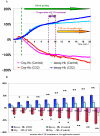A novel system for transcutaneous application of carbon dioxide causing an "artificial Bohr effect" in the human body
- PMID: 21931656
- PMCID: PMC3169585
- DOI: 10.1371/journal.pone.0024137
A novel system for transcutaneous application of carbon dioxide causing an "artificial Bohr effect" in the human body
Abstract
Background: Carbon dioxide (CO(2)) therapy refers to the transcutaneous administration of CO(2) for therapeutic purposes. This effect has been explained by an increase in the pressure of O(2) in tissues known as the Bohr effect. However, there have been no reports investigating the oxygen dissociation of haemoglobin (Hb) during transcutaneous application of CO(2)in vivo. In this study, we investigate whether the Bohr effect is caused by transcutaneous application of CO2 in human living body.
Methods: We used a novel system for transcutaneous application of CO(2) using pure CO(2) gas, hydrogel, and a plastic adaptor. The validity of the CO(2) hydrogel was confirmed in vitro using a measuring device for transcutaneous CO(2) absorption using rat skin. Next, we measured the pH change in the human triceps surae muscle during transcutaneous application of CO(2) using phosphorus-31 magnetic resonance spectroscopy ((31)P-MRS) in vivo. In addition, oxy- and deoxy-Hb concentrations were measured with near-infrared spectroscopy in the human arm with occulted blood flow to investigate O2 dissociation from Hb caused by transcutaneous application of CO(2).
Results: The rat skin experiment showed that CO(2) hydrogel enhanced CO(2) gas permeation through the rat skin. The intracellular pH of the triceps surae muscle decreased significantly 10 min. after transcutaneous application of CO(2). The NIRS data show the oxy-Hb concentration decreased significantly 4 min. after CO(2) application, and deoxy-Hb concentration increased significantly 2 min. after CO(2) application in the CO(2)-applied group compared to the control group. Oxy-Hb concentration significantly decreased while deoxy-Hb concentration significantly increased after transcutaneous CO(2) application.
Conclusions: Our novel transcutaneous CO(2) application facilitated an O(2) dissociation from Hb in the human body, thus providing evidence of the Bohr effect in vivo.
Conflict of interest statement
Figures






Similar articles
-
Transcutaneous carbon dioxide application with hydrogel prevents muscle atrophy in a rat sciatic nerve crush model.J Orthop Res. 2018 Jun;36(6):1653-1658. doi: 10.1002/jor.23817. Epub 2017 Dec 19. J Orthop Res. 2018. PMID: 29193246
-
Effect of haemoglobin oxygenation on Bohr proton release and CO2 excretion in the rainbow trout.Respir Physiol. 1996 Oct;106(1):65-70. doi: 10.1016/0034-5687(96)00061-8. Respir Physiol. 1996. PMID: 8946578
-
Red blood cell pH, the Bohr effect, and other oxygenation-linked phenomena in blood O2 and CO2 transport.Acta Physiol Scand. 2004 Nov;182(3):215-27. doi: 10.1111/j.1365-201X.2004.01361.x. Acta Physiol Scand. 2004. PMID: 15491402 Review.
-
The effect of transcutaneous application of carbon dioxide (CO₂) on skeletal muscle.Biochem Biophys Res Commun. 2011 Apr 1;407(1):148-52. doi: 10.1016/j.bbrc.2011.02.128. Epub 2011 Mar 1. Biochem Biophys Res Commun. 2011. PMID: 21371433
-
T-quaternary structure of oxy human adult hemoglobin in the presence of two allosteric effectors, L35 and IHP.Biochim Biophys Acta. 2011 Oct;1807(10):1253-61. doi: 10.1016/j.bbabio.2011.06.004. Epub 2011 Jun 15. Biochim Biophys Acta. 2011. PMID: 21703224
Cited by
-
Transcutaneous carbon dioxide application suppresses the expression of cancer-associated fibroblasts markers in oral squamous cell carcinoma xenograft mouse model.PLoS One. 2023 Aug 18;18(8):e0290357. doi: 10.1371/journal.pone.0290357. eCollection 2023. PLoS One. 2023. PMID: 37594996 Free PMC article.
-
Increase in carbon dioxide accelerates the performance of endurance exercise in rats.J Physiol Sci. 2018 Jul;68(4):463-470. doi: 10.1007/s12576-017-0548-6. Epub 2017 Jun 10. J Physiol Sci. 2018. PMID: 28601950 Free PMC article.
-
Transcutaneous CO2 application combined with low-intensity pulsed ultrasound accelerates bone fracture healing in rats.BMC Musculoskelet Disord. 2024 Oct 29;25(1):863. doi: 10.1186/s12891-024-07976-z. BMC Musculoskelet Disord. 2024. PMID: 39472824 Free PMC article.
-
Novel CO2-encapsulated Pluronic F127 hydrogel for the treatment of Achilles tendon injury.Sci Rep. 2023 Dec 11;13(1):21895. doi: 10.1038/s41598-023-49339-z. Sci Rep. 2023. PMID: 38081952 Free PMC article.
-
Transcutaneous Carbon Dioxide Improves Contractures After Spinal Cord Injury in Rats.Clin Orthop Relat Res. 2019 Aug;477(8):1934-1946. doi: 10.1097/CORR.0000000000000808. Clin Orthop Relat Res. 2019. PMID: 31135536 Free PMC article.
References
-
- Blair DA, Glover WE, McArrdle L. The mechanism of the peripheral vasodilation following carbon dioxide inhalation in man. Clin Sci. 1960;19:407–423.
-
- Matz H, Orion E, Wolf R. Balneotherapy in dermatology. Dermatol Ther. 2003;16:132–140. - PubMed
-
- Hartmann BR, Bassenge E, Pittler M. Effect of carbon dioxide-enriched water and fresh water on the cutaneous microcirculation and oxygen tension in the skin of the foot. Angiology. 1997;48:337–343. - PubMed
-
- Hartmann BR, Bassenge E, Hartmann M. Effects of serial percutaneous application of carbon dioxide in intermittent claudication: results of a controlled trial. Angiology. 1997;48:957–963. - PubMed
-
- Toriyama T, Kumada Y, Matsubara T, Murata A, Ogino A, et al. Effect of artificial carbon dioxide foot bathing on critical limb ischemia (Fontaine IV) in peripheral arterial disease patients. Int Angiol. 2002;21:367–73. - PubMed
Publication types
MeSH terms
Substances
LinkOut - more resources
Full Text Sources
Other Literature Sources
Medical

